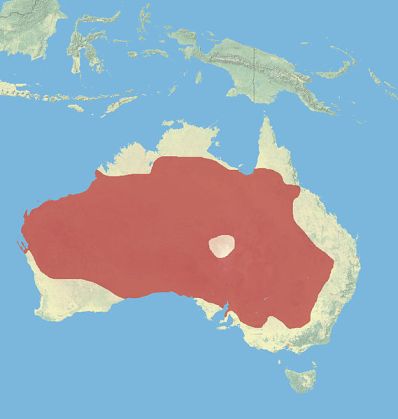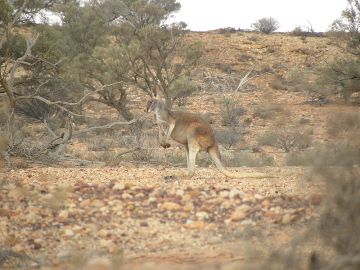Red Kangaroo (Macropus rufus)
Habitat & Interactions

The Red Kangaroo’s home lies in the northern portion of
Australia, known as the Tropical Australian Savanna. This region
has two seasons, a wet season and a dry season (2001). Each of
these seasons lasts roughly 5 to 6 months(2001).The Wet Season
tends to be warmer than the dry season, mostly due to increased
humidity(2001). Temperatures during this season hover around
85°F, reaching highs in the 120°F range in the central-most
Savanna(2001). The Red Kangaroo inhabits more of the internal
portion of the savanna, staying away from the northern coastline
for the most part. The wet season’s increased precipitation is
caused by rain being pushed south from the equator to the
northern portion of Australia (2001). However, as you move away
from the northern coastline, the amount of precipitation
received during the wet season decreases. For the Red Kangaroo
this means that even during the wet season there is not an
abundant amount of water available to them. Also, due to the dry
conditions maintained most of the year, the precipitation that
does occur causes flooding and is quickly flushed away, leaving
no reliable source of water at any point during the year(2001).
The dry season is during the colder months of the year. Very
little rain falls during these months, leaving little water
available to any form of life.

In order to combat these sometimes extreme conditions, each
kangaroo is said to create its own “home range”(McCullough,
2000). A home range can be described as a certain area of land
where any given animal occupies most of their time. The Red
Kangaroo does venture out of this home range, but most of the
nutrients, shade, and in some cases water, can be found in this
range (McCullough, 2000). A water source is not of primary
concern when developing a home range since most of the water
needed for the Red Kangaroo is obtained from its diet, as
described in the Nutrition section. The home range of the Red
Kangaroo is said to be the largest of all the marsupials, with
the male Red Kangaroo to have a larger home range than females
(McCullough, 2000). On average, males had a home range of almost
20 km2 and females to be around 11km2(McCullough, 2000). Due to
the extreme conditions of the savanna, a major determinant of
the home range is shelter (McCullough, 2000). For the kangaroo,
shelter can be described as anything that will provide shade
from the sun, such as a small cluster of trees.
Due to the red kangaroo’s relatively uninhabitable home, there
are not really many interactions with other animals. While the
kangaroo tends not to want to be alone, it also has no desire to
be in large mobs (Caughley, 1964). All species of kangaroos seem
to exhibit the same behavior when it comes to interactions with
another. Typically kangaroos will form loosely bound groups that
have overlapping home ranges (Caughley, 1964). The man predators
of the red kangaroo are the dingo, eagles, and humans (Croft,
2010). Young joeys are far more susceptible to predation from
dingos and eagles because of their smaller size (Croft, 2010).
Farmers often find kangaroos in their fenced in grazing fields
where there is a reliable food source and protection from the
dingos (Croft, 2010). However, these kangaroos are seen as a
pest who is eating the farmer’s livestock’s food source, and so
they are sometimes killed (Croft, 2010).
To return to Home Page click here